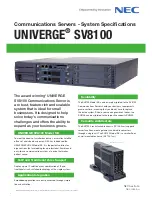
32
Connecting from Two Different Networks
*
Synology Disk Station
supports dual LAN allowing you to connect to the network
with two LAN cables at the same time, or to set the
Synology Disk Station
using
two IP addresses under different subnets. With Link Aggregation enabled,
trunking and network fault tolerances are supported. Please go to the "System >
Network" page of the Web Management UI for setup.
Volume
*
You can combine hard drives on
Synology Disk Station
to create different types
of volumes, and find the data protection level of your need. The
Synology Disk
Station
provides you various volume types as follows:
Volume
Type
Amount of
composed
hard drive
Functionality
Basic
1
A Basic (non-RAID) volume must be created with one hard
drive as an independent unit. When creating a Basic
volume, you can select only one hard drive at a time.
JBOD
≧
2
JBOD is a collection of hard drives. The maximum capacity
of a JBOD volume is the total capacity of all hard drives.
RAID 0
≧
2
Combining multiple disks to build a volume, RAID 0 offers
Striping, a process of dividing data into blocks and spreading
the data blocks across several hard drives, but without
safety measures.
RAID 1
2
With RAID 1, one of the composed disks is used for backup
purposes. The content of disk A is mirrored to disk B to
assure data integrity, so the actual available storage
capacity equals to the capacity of one hard drive.
RAID 5
≧
3
This configuration includes a backup option. It uses parity
mode to store redundant data on space equal to the size of
one disk for later data recovery. Therefore the actual
available storage capacity equals to the capacity of n-1 hard
drives.
RAID
5+Spare
≧
4
RAID 5+Spare is a new management mechanism to secure
the data. It requires at least four drives to establish a RAID
5+Spare volume, and one will act as a hot Spare drive to
rebuild the failed drive of the volume automatically.
RAID 6
≧
4
This volume type eliminates the risk of volume failure and
provides extra data protection. It uses parity mode to store
redundant data on space equal to the size of two disks for
later data recovery. Therefore the actual available storage
capacity equals to the capacity of n-2 hard drives.
*
Supported on specific models only. Please refer to the product Specification table.
















































